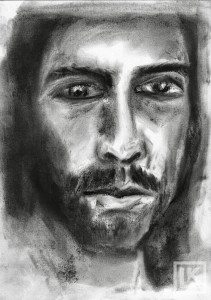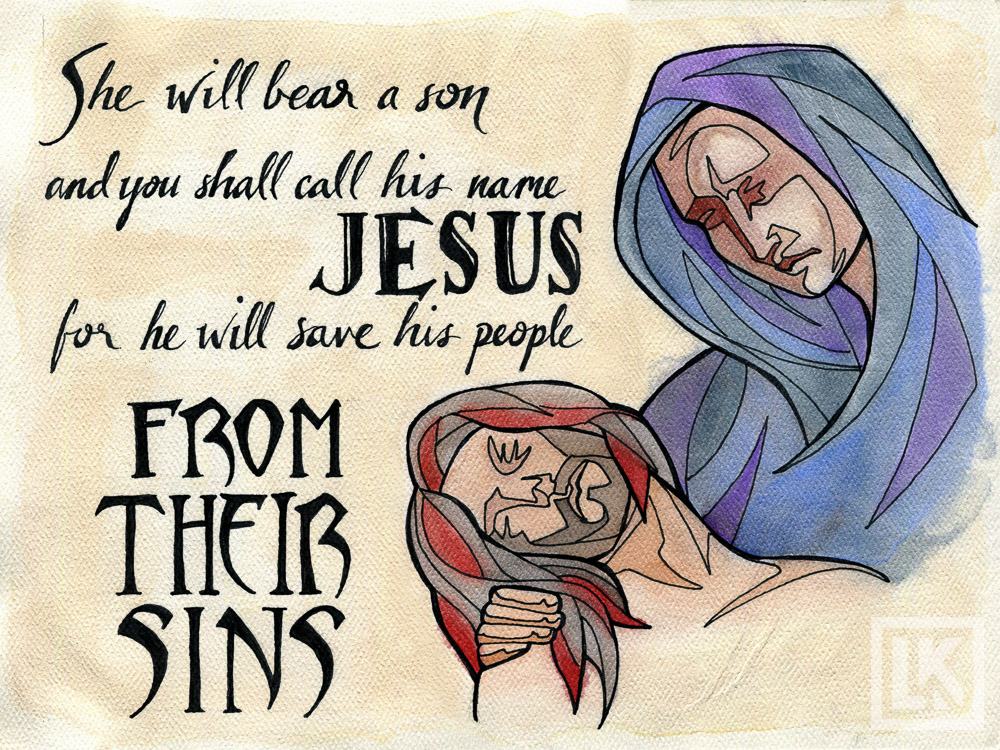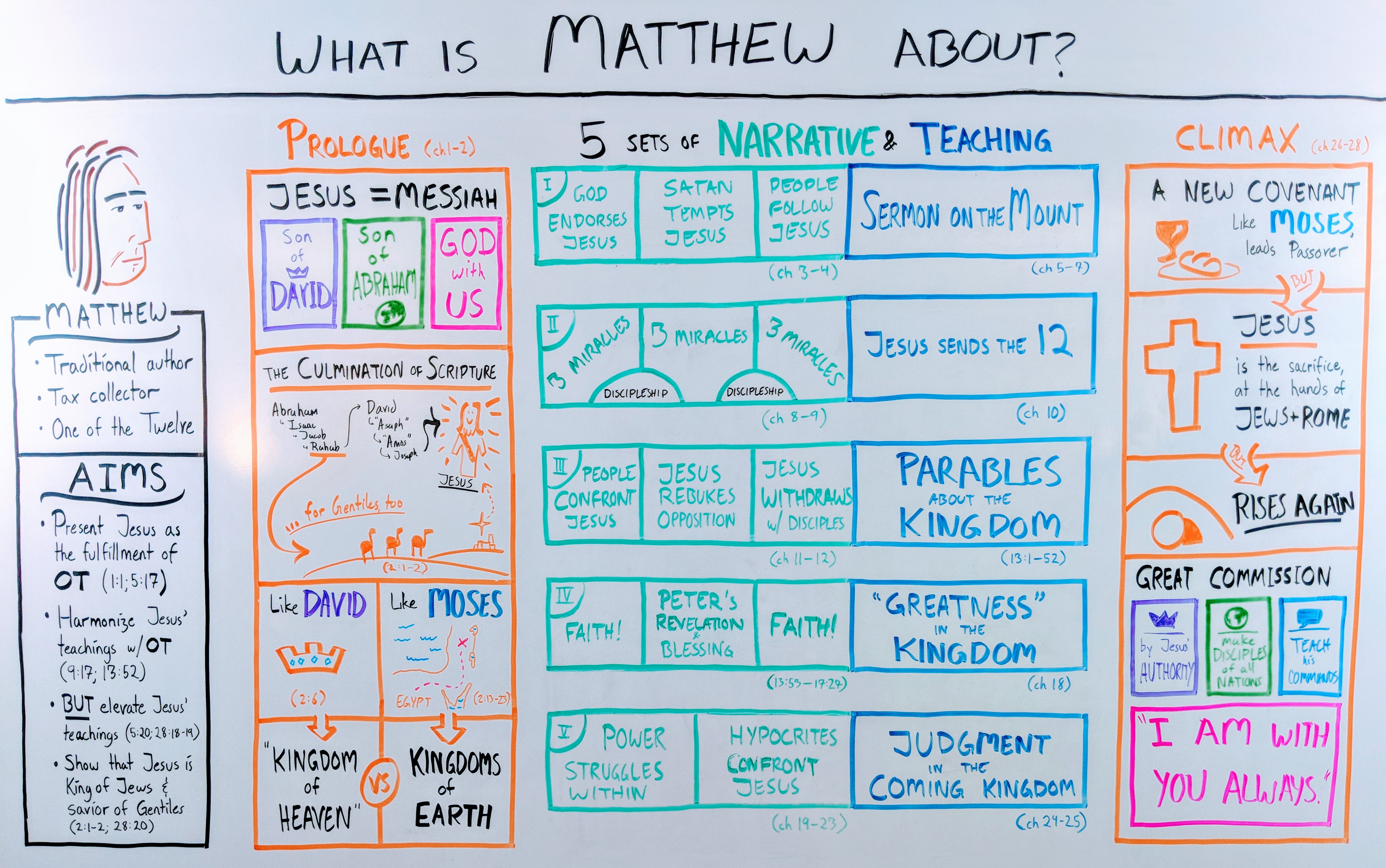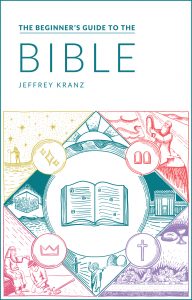The book of Matthew is the first Gospel (an account of Jesus’ life and ministry) in the New Testament. In Matthew, Jesus teaches people what it means to be part of his kingdom, the “kingdom of heaven.” He is betrayed and crucified. He rises again and commissions His disciples to spread the good news.
The apostle Matthew (who is traditionally credited with writing this book) seems to have written this Gospel to a Christian audience who was either Jewish or highly familiar with the Jewish religion. Matthew presents Jesus as the Messiah (Mt 1:1), the promised descendant of King David who would bring God’s kingdom to earth and establish a time of peace and justice. Matthew quotes the Old Testament extensively, and places special emphasis on Jesus’ fulfillment of prophecies—which would have been important to a Jewish audience. Matthew tells us the story of Jesus with an emphasis on His role as Messiah, or Christ:
- Jesus is the son of God. He is conceived by the Holy Spirit in Mary’s womb (Mt 1:18–20), and God endorses Jesus as His beloved Son (Mt 3:17). He is God incarnate, living among men (Mt 1:23).
- Jesus is the king. He is the son of King David (Mt 1:1). Jesus repeatedly declares that the kingdom of heaven is at hand (Mt 4:17), and tells many parables about it. The book of Matthew makes more mentions of the “kingdom of heaven” of “kingdom of God” than any of the other Gospels.
- Jesus is the promised savior. He is the son of Abraham, through whom God had promised to bless all nations of the earth. Matthew emphasizes the Old Testament prophecies that Jesus fulfills, from His birth (Mt 1:22–23; 2:5–6, 17–18) through His ministry and right up to His death and resurrection. He lives a righteous life, teaches us what it means to be righteous, and dies on a cross so that we can be right with God.
Matthew opens with a simple statement of who Jesus is (the Messiah), and closes with a simple statement of what we should do (make disciples for Him).
Theme verse of Matthew
“She will bear a Son; and you shall call His name Jesus, for He will save His people from their sins.” (Mt 1:21)
Why Matthew was written
 Unlike John, Matthew doesn’t state his purpose explicitly. However, his opening verse makes it very clear what this book is about: Jesus, the Messiah, the son of David, the son of Abraham. The rest of this Gospel presents evidence of who Jesus is.
Unlike John, Matthew doesn’t state his purpose explicitly. However, his opening verse makes it very clear what this book is about: Jesus, the Messiah, the son of David, the son of Abraham. The rest of this Gospel presents evidence of who Jesus is.
Outline of Matthew
Matthew is a phenomenal work of literature, arranged in a way that presents Jesus as the ultimate Jewish hero: the Messianic son of David, the prophet who surpasses Moses, and the seed of Abraham that blesses all the nations. These big themes are introduced in the book’s prologue, explored in the large middle section, and then resolved in the climax.
The bulk of Matthew is arranged into five main sections (which may have been in reference to the five-fold Law of Moses). Each section opens with stories of Jesus’ life and ministry, and closes with a long set of teachings from Jesus, called “discourses.”
- Prologue: Jesus’ birth and significance (Mt 1–2)
- Jesus’ teaching and ministry (Mt 3–25)
- Book 1 (Mt 3–7)
- Jesus gains followers (Mt 3–4)
- Sermon on the Mount (Mt 5–7)
- Book 2 (Mt 8–10)
- Jesus works miracles (Mt 8–9)
- Jesus sends his disciples (Mt 10)
- Book 3 (Mt 11–13:52)
- Jesus is confronted, withdraws (Mt 11–12)
- Parables about the kingdom (Mt 13:1–52)
- Book 4 (Mt 13:53–18:35)
- Jesus is revealed as the son of God (Mt 13:53–17:27)
- How “greatness” works in the Kingdom (Mt 18)
- Book 5 (Mt 19–25)
- People struggle with Jesus’ kingship (Mt 19–23)
- Teachings of judgment in the kingdom to come (Mt 24–25)
- Book 1 (Mt 3–7)
- Climax: Jesus’ sacrifice, victory, and commission to his disciples (Mt 26–27)
More pages related to Matthew
- Mark (next book of the Bible)
- Malachi (previous)
- Guide to the four Gospels
- Luke
- John





